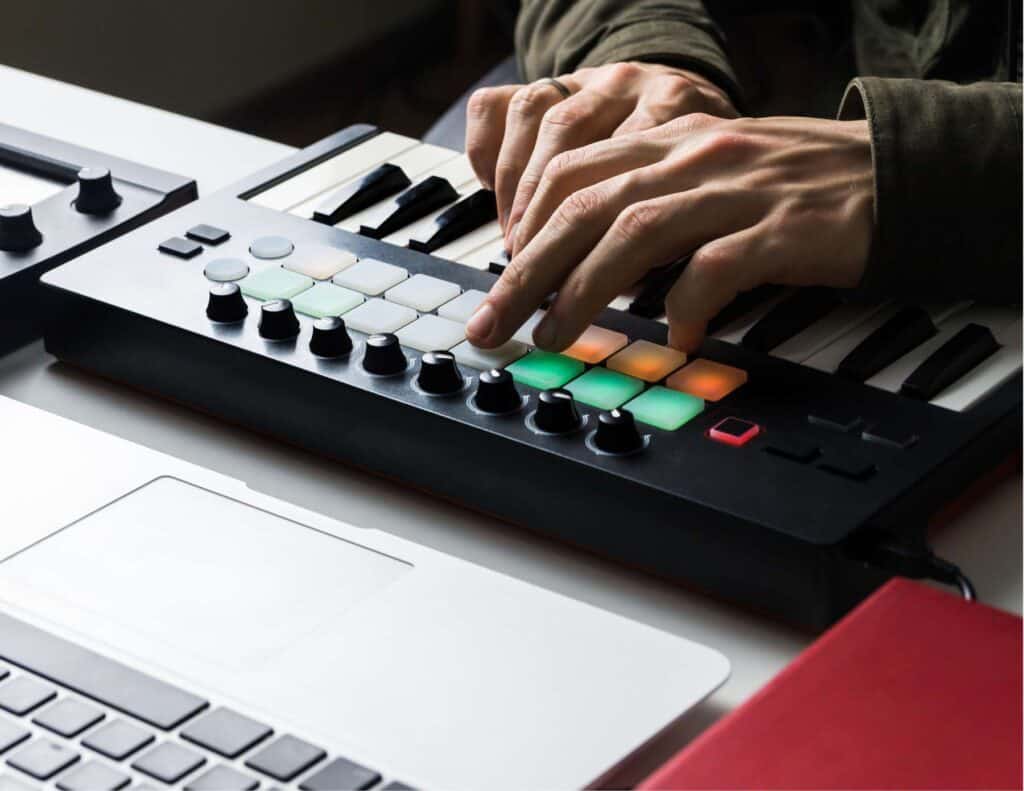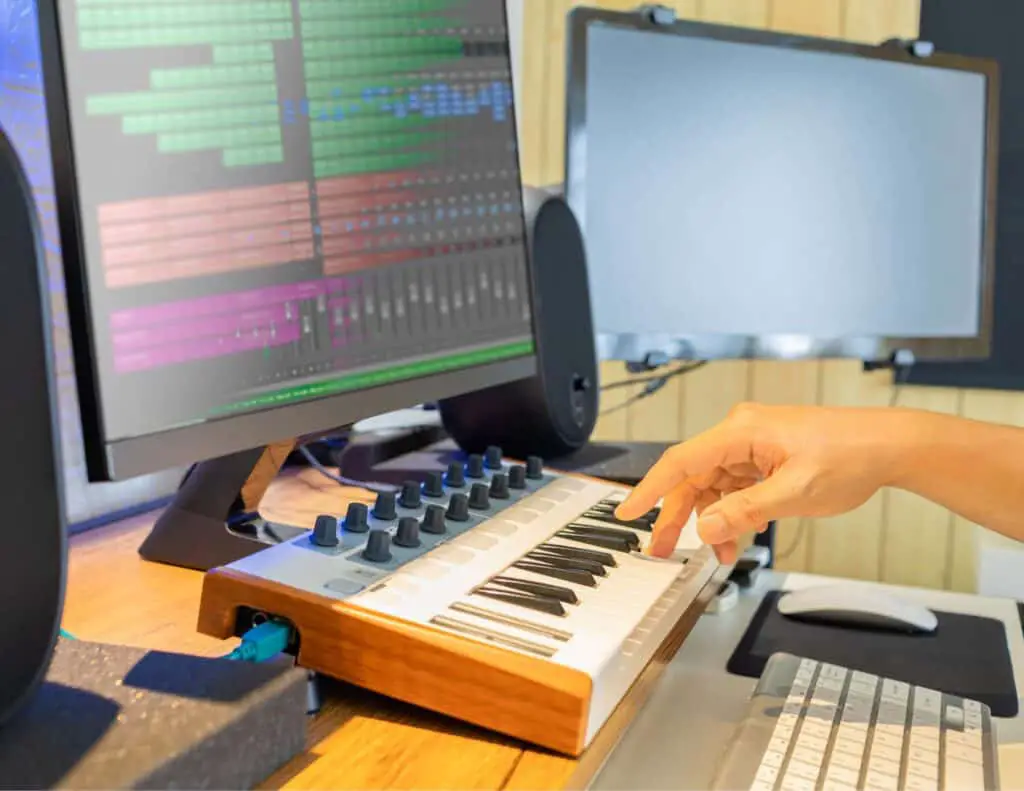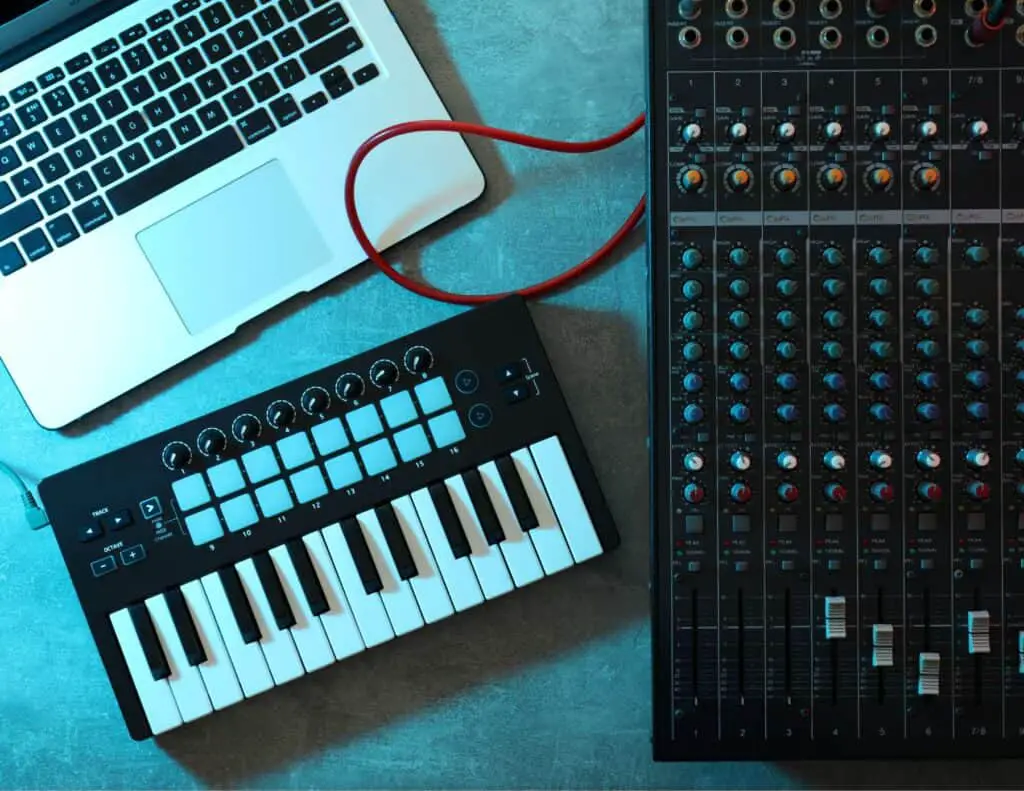
MIDI is a technical standard that describes a communications protocol, digital interface, and electrical connectors that connect a wide variety of electronic musical instruments, computers, and related audio devices for playing, editing, and recording music.
MIDI instruments can be used to create various types of music, ranging from classical to electronic dance music. It seems like in recent years the term “MIDI” isn’t used quite as much as it once was and people new to making digital music might find the concept of MIDI instruments a bit daunting.
That’s where this article comes in. While you don’t have to become a computer scientist to understand MIDI, having a solid understanding of how these instruments work can make getting quality music productions a lot easier or at least more intuitive!
Key Takeaways:
- MIDI instruments use a standardized language to represent musical parameters.
- MIDI instruments can be connected to computers and other devices, allowing for real-time performance and recording.
- Understanding MIDI instruments is essential for anyone interested in creating or producing music.
Table of Contents
What are MIDI Instruments?
MIDI instruments are electronic musical instruments that use the Musical Instrument Digital Interface (MIDI) protocol to communicate with other MIDI-compatible devices, such as computers and synthesizers. MIDI instruments allow musicians to create and manipulate digital music in real-time.
MIDI instruments come in many different forms, including keyboards, synthesizers, guitars, basses, strings, reeds, flutes, percussion, and button controllers. MIDI keyboards are perhaps the most common type and are designed to mimic the functionality of a traditional piano or organ.
MIDI keyboards typically have between 25 and 88 keys, and they can be used to control a variety of different sounds and effects.
Synthesizers are another popular type of MIDI instrument, and they are designed to create and manipulate digital sounds in real-time. Synthesizers can be used to create a wide range of different sounds, from simple piano and organ sounds to complex electronic textures and effects.
MIDI controllers are another type of MIDI instrument, and they are designed to provide musicians with more precise control over their digital music. MIDI controllers can be used to manipulate a variety of different parameters, including pitch, volume, tempo, and more.
One of the key benefits of these instruments is that they are highly customizable. Musicians can use MIDI to create and manipulate their own unique sounds and effects, and they can easily share their creations with other musicians and producers.

Types of MIDI Instruments
MIDI Keyboards
MIDI keyboards are the most common type of MIDI instrument. They are designed to mimic the functionality of traditional pianos, but with the added benefit of MIDI connectivity. MIDI keyboards can be used to play a wide range of sounds, including pianos, strings, and synthesizers.
Drum Pads
Drum pads (or drum machines) are another popular type of MIDI instrument. They are designed to create drum patterns and beats, and they can be used in a wide range of musical genres, from hip-hop to rock. Drum machines often come with a range of built-in drum sounds, but they can also be used to trigger samples from other MIDI instruments.
Guitars
A MIDI guitar looks and feels like a standard guitar, but instead of solely producing audio signals when the strings are plucked, it generates MIDI data. This data can be interpreted by synthesizers, computers, and other electronic devices to produce a vast array of sounds, from classic guitar tones to pianos, violins, or even drums.
Drawbar Organs
Drawbar organs are a type of MIDI instrument that mimics the sound of traditional pipe organs. They are commonly used in gospel, jazz, and rock music and are known for their distinctive sound. Drawbar organs can be played using a MIDI keyboard or other MIDI controller.
Violins and Recorders
MIDI violins and recorders are designed to mimic the sound of their acoustic counterparts. They can be played using a MIDI keyboard or other MIDI controller and are often used in classical and folk music.
Pianos
MIDI pianos come in various types, including acoustic grand pianos, bright acoustic pianos, electric grand pianos, honky-tonk pianos, electric pianos 1 and 2, and harpsichords. They are designed to mimic the sound of traditional pianos and can be played using a MIDI keyboard or other MIDI controller.
Chromatic Percussion and Celesta
MIDI chromatic percussion instruments, including xylophones, marimbas, and vibraphones, are designed to mimic the sound of traditional percussion instruments. Celestas are also a type of MIDI instrument that produces a bell-like sound and is commonly used in orchestral music.
How MIDI Instruments Work
MIDI instruments use a technology that allows musicians to communicate with their hardware or software instruments. MIDI stands for Musical Instrument Digital Interface. It is a protocol that enables electronic musical instruments, computers, and other devices to communicate and synchronize with each other.
MIDI instruments work by sending and receiving MIDI messages. These messages contain information about the notes played, the velocity, the volume, and other parameters that affect the sound. MIDI messages are sent over MIDI channels, which are like virtual cables that connect MIDI devices.
MIDI instruments can produce a wide range of sounds and effects. They can simulate the sound of traditional instruments like pianos, drums, and guitars, or create new and unique sounds. MIDI instruments can also apply effects like vibrato, pitch bend, and patches to the sound.
MIDI instruments can be hardware or software based. Hardware MIDI instruments are physical devices that produce sound, like synthesizers or drum machines. Software MIDI instruments are virtual instruments that run on a computer or mobile device.
MIDI instruments are commonly used in recording studios and live performances. They allow musicians to create and sequence music with precision and control. MIDI instruments can also sync with other devices like drum machines, sequencers, and synthesizers to create complex and dynamic musical arrangements.
With the introduction of MIDI 2.0, MIDI instruments are becoming even more advanced and versatile. MIDI 2.0 offers improved speed, resolution, and compatibility, making it easier for musicians to communicate and collaborate with each other.
MIDI Instrument Connectivity
MIDI (Musical Instrument Digital Interface) is a language that allows digital music gear to communicate with each other. MIDI instruments can be connected to each other using various methods, including USB, digital interface, cables, and Ethernet.
When connecting MIDI instruments, it is important to consider the type of cable used. DIN-MIDI and USB-MIDI connections both have limitations, with USB-MIDI cables being very short. This can be problematic in a studio or on stage with lots of MIDI gear. However, MIDI thru ports can be used to daisy-chain multiple MIDI devices together.
Computers can also be used to connect MIDI instruments. MIDI data can be transmitted to a computer via a MIDI interface with a USB-DAW connection. Firewire and Ethernet connections can also be used to connect MIDI instruments to a computer.

Use of Midi Instruments in a Studio
MIDI instruments are an essential part of any modern studio setup. They allow musicians and producers to create and control music in a digital environment, offering a level of flexibility and precision that was previously impossible with traditional analog instruments.
In a studio setting, MIDI instruments can be used in a variety of ways. For example, they can be used to trigger sounds from virtual instruments within a digital audio workstation (DAW). This allows producers to create complex arrangements using a wide range of sounds and effects, all within a single software environment.
MIDI instruments can also be used to control hardware synthesizers and other electronic instruments. This allows musicians to create unique sounds and textures that would be difficult or impossible to achieve with traditional acoustic instruments.
One of the key advantages of MIDI instruments in a studio setting is the ability to easily edit and manipulate MIDI data. Most DAWs (such as my favorite, Cubase) offer powerful sequencing and editing tools, such as piano roll editors, that allow producers to fine-tune their MIDI performances with precision and ease.
MIDI instruments are also commonly used in live performance settings, where they offer a level of control and flexibility that is difficult to achieve with traditional instruments. For example, a keyboardist can use a MIDI controller to trigger a wide range of sounds and effects, all while controlling parameters such as volume, pitch, and modulation in real-time.
MIDI Instrument Manufacturers
There are many manufacturers of MIDI instruments, including some of the most well-known names in the music industry. These manufacturers produce a wide variety of instruments, from keyboards and synthesizers to drum machines and controllers.
One of the most prominent MIDI instrument manufacturers is Roland, which has been producing MIDI instruments for over 30 years. Roland is known for its high-quality keyboards and synthesizers, as well as its drum machines and other MIDI controllers.
Another important player in the MIDI instrument market is the MIDI Manufacturers Association, which is an industry group that works to promote the use of MIDI technology in music production. The association is made up of a number of different companies that produce MIDI instruments, including Roland, Yamaha, and Dave Smith Instruments.
Speaking of Yamaha, the company is another major player in the MIDI instrument market. Yamaha produces a wide range of MIDI instruments, including keyboards, synthesizers, and drum machines. The company is known for its high-quality products and its innovative use of technology in its instruments.
Dave Smith Instruments is another important manufacturer of MIDI instruments. The company was founded by Dave Smith, who is considered to be one of the pioneers of MIDI technology. Dave Smith Instruments produces a range of synthesizers and other MIDI instruments that are known for their high-quality sound and innovative features.
Advanced MIDI Instrument Features
MIDI instruments have come a long way since their inception in the early 80s. Today, they offer a wide range of advanced features that allow musicians and producers to create complex and nuanced music. In this section, we’ll take a look at some of the most important advanced MIDI instrument features.
Polyphony
Polyphony refers to the number of notes that a MIDI instrument can play simultaneously. Most MIDI instruments today offer polyphony of at least 64 notes, and some can play up to 128 notes at once. This allows musicians and producers to create complex and layered compositions that would be impossible with a traditional instrument.
Reverb
Reverb is an effect that simulates the natural echo and reverberation of a physical space. Many MIDI instruments today offer built-in reverb effects that can be adjusted to create a wide range of different sounds. This is particularly useful for creating atmospheric and ambient music.
MIDI Sequencing
MIDI sequencing refers to the process of recording and editing MIDI data in a digital audio workstation (DAW). Most MIDI instruments today are compatible with MIDI sequencing software, which allows musicians and producers to create complex compositions with ease. MIDI sequencing also allows for precise editing of individual notes and effects.
General MIDI Level 1 and 2
General MIDI (GM) is a standardized specification for MIDI instruments that ensures compatibility between different instruments. General MIDI Level 1 offers a basic set of 128 instrument sounds, while General MIDI Level 2 offers an expanded set of 256 sounds. Most modern MIDI instruments are compatible with General MIDI Level 1 and 2.
NKS
NKS (Native Kontrol Standard) is a protocol developed by Native Instruments that allows for seamless integration between MIDI instruments and software. NKS-compatible instruments offer advanced mapping and control features that allow for quick and easy access to software parameters.
CC (Control Change)
CC (Control Change) messages are a type of MIDI message that allow for real-time control of different parameters on a MIDI instrument. Many MIDI instruments today offer advanced CC mapping features that allow for precise control over a wide range of parameters.
Power
Finally, it’s worth noting that many MIDI instruments today offer advanced power features, such as battery operation and USB power. This allows musicians and producers to use their instruments in a wide range of settings, from the studio to the stage.

Frequently Asked Questions
How can MIDI be used in music production?
MIDI is a powerful tool for music production. It can be used to record, edit, and play back musical performances. MIDI allows musicians to create and manipulate sounds in ways that would be impossible with traditional instruments. It also makes it easy to collaborate with other musicians, regardless of their location.
What are some examples of MIDI instruments?
There are many different types of MIDI instruments, including keyboards, drum machines, and synthesizers. MIDI instruments can be hardware or software-based. Some popular examples of MIDI instruments include the Roland TR-808 drum machine, the Yamaha DX7 synthesizer, and the Akai MPC.
What is the purpose of MIDI in computer technology?
MIDI is a protocol that allows electronic musical instruments to communicate with each other and with computers. MIDI is used extensively in computer technology to control software synthesizers, sequencers, and other music software. It is also used to control lighting and other stage effects in live performances.
What are the different types of MIDI?
There are three different types of MIDI messages: channel messages, system messages, and real-time messages. Channel messages are used to control individual MIDI channels, while system messages are used to control global settings. Real-time messages are used to synchronize multiple MIDI devices.
What is the full form of MIDI in computer science?
MIDI stands for Musical Instrument Digital Interface. It is a protocol that was developed in the early 1980s to allow electronic musical instruments to communicate with each other and with computers.
How do you connect MIDI instruments to a computer?
MIDI instruments can be connected to a computer using a MIDI interface or a USB cable. Once connected, the MIDI instrument can be controlled using music software such as a sequencer or a virtual instrument. MIDI instruments can also be connected to other MIDI devices, allowing for complex musical arrangements.

